Shipyard named after 61 communard. Squadron battleship "Prince Potemkin-Tavrichesky"
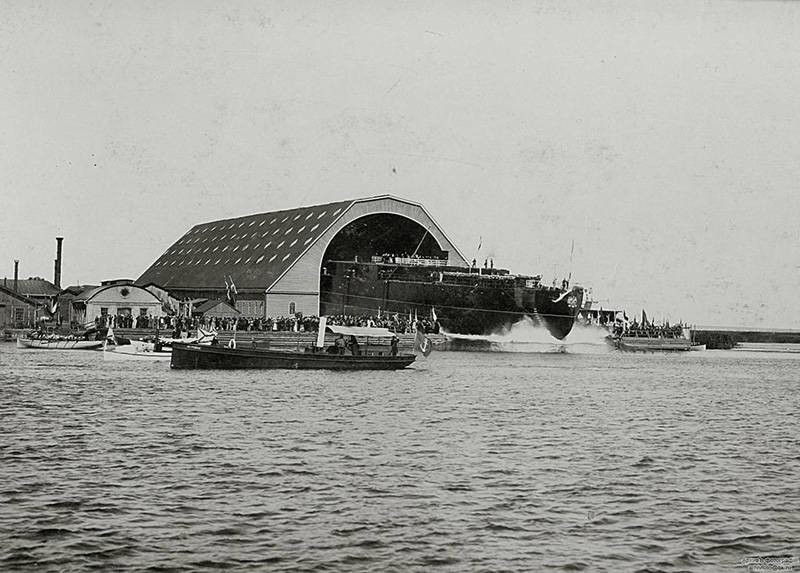
Very soon, the Nikolaev Admiralty will cease to be the only large enterprise of this profile in the city. In the same year 1895, with the active participation of the Belgian and French capital, work began on the construction of a new plant. In Nikolaev, and later in the official documentation, the name “Naval” was firmly attached to him - not least because of the abundance of foreign specialists speaking the language of Jules Verne and Alexander Dumas. Later, the new shipyard will be Chernomorsky Shipyard, one of the largest in the USSR and Europe.
In the meantime, the old Nicholas Admiralty continued to build ships. And he was waiting for his turn, first on the drawing sheets, and then slowly growing on the slipway, the squadron battleship "Prince Potemkin-Taurian".
Modeled on the Three Hierarchs
The twenty-year shipbuilding program for the needs of the Black Sea Fleet was coming to an end, and the eighth squadron battleship was to crown it. As already happened, there were no clear plans for a new ship in the high naval offices. Nevertheless, the command of the Black Sea Fleet, still using the remnants of autonomy, in 1895, it was proposed to independently determine the type of new battleship, which would most closely correspond to local tasks.
The main naval headquarters was waiting for an answer to its request, and in Sevastopol and Nikolaev there were heated disputes at meetings, and sketched slate on drawing boards. The idea of compactness was still in the Black Sea environment, and in response to Admiral Chikhachev, the head of the Marine Ministry, Vice Admiral Kopytov proposed a possible new variation "The Twelve Apostles".
According to Kopytov, this ship, with its modest size, had excellent seaworthiness and draft. The Vice Admiral suggested developing a project based on an improved version of the Twelve Apostles. This ship was supposed to be equipped with the latest Belville water tube boilers, which needed to be transferred to oil heating. Fuel reserves were reduced due to the transition from coal to fuel oil. Vice Admiral Kopytov hoped that with all the innovations listed and not yet mentioned, the prospective battleship would be able to develop speed to the then unlikely 20 nodes.
Having studied the proposal of the command of the Black Sea Fleet, Admiral Chikhachev and the Chairman of the Marine Technical Committee, Vice Admiral Pilkin, in December 1895 of the year gave their conclusions to Kopytov. They explained to Vice Admiral Kopytov a slightly different opinion: since with a fully possible operation in the Bosporus, the battleship will have to deal with coastal fortifications located at altitudes, the new ship must have closed towers and not open barbet installations that were on the Twelve Apostles. For better protection, the refusal of barbet installations was strongly recommended - Kopytov was given to understand that ships like "Three Saints" и Rostislav. The hypothetical speed in 20 nodes was declared unreachable in Petersburg and was not considered further.
At the beginning of 1896, Vice Admiral Kopytov got acquainted in the Maritime Technical Committee with the blueprints of the Peresvet squadron battleship under construction at the Baltic plant. With a displacement of 12 thousand tons, he had 254-mm guns of the main caliber, located in the towers. After weighing the pros and cons, the Maritime Technical Committee agreed to the development of the project.
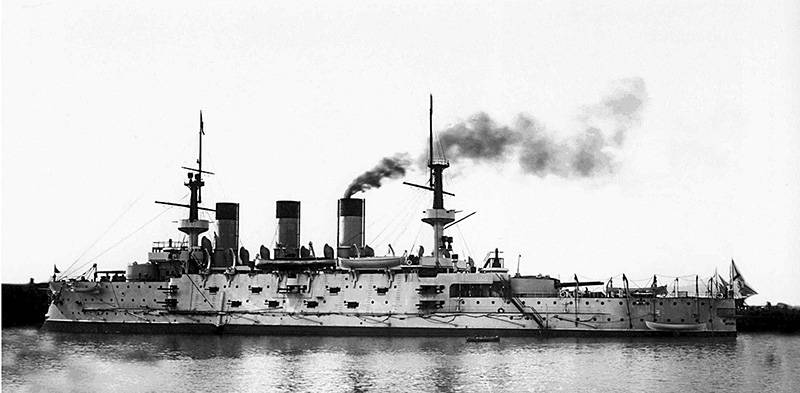
In Nikolaev, under the direction of the port ship engineer of the senior shipbuilder N. V. Mikhailov, a draft design began, which by the summer of 1896 was generally ready. The creative process was in full swing when the high authorities intervened. In early June of the same year, General-Admiral Grand Prince Alexei Alexandrovich ordered the General Directorate of Shipbuilding and Supplies to build a new Black Sea battleship completely modeled on the Three Hierarchs.
After just a week, after an exchange of views with the ranks of the maritime department, the admiral general softened the wording: instead of the categorical “exactly as the Three Saints,” now appeared more streamlined, “like the Three Saints.” Alexey Alexandrovich, in a bureaucratic manner, insisted that the new ship be as far as possible free from the shortcomings of its prototype and embody all the latest achievements of science and technology.
The armor protection of the battery of the 152-mm guns must be significantly strengthened, the guns themselves are separated from each other by armored traverses. Considering the “monitor” low-profile nature of the Three Hierarchs, the height of the freeboard in the nose part needed to be raised, along with it the height of the main caliber tower above the horizon increased.
Since the surface area after such changes became larger, it was allowed to use armor plates of reduced thickness - 102 mm. The situation with floodability was planned to be improved with the use of cofferdams, by analogy with the latest French battleships of the Charlemagne type.
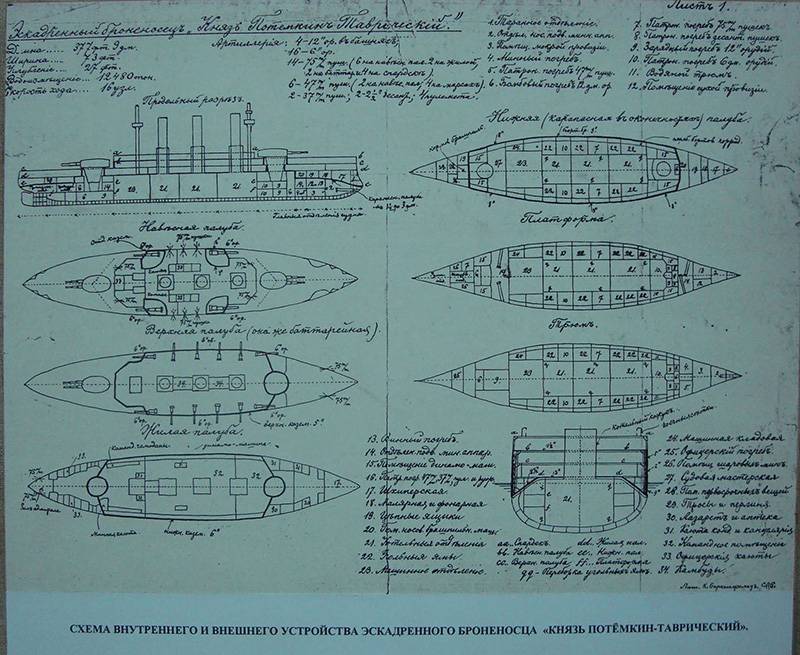
It was recommended not to delay the design work. The shipbuilding department of the Marine Technical Committee, together with other departments under the leadership of the Chief Inspector of Shipbuilding Nikolai Yevlampievich Kuteynikov, began work on drawing up a technical assignment for the new battleship "like the Three Hierarchs".
July 26 Vice-Admiral Kopytov with his order on the Black Sea Fleet appointed the builder of the ship. They became the ship engineer of the Sevastopol military port - the senior assistant shipbuilder Alexei Ernestovich Shott. 42-year-old Schott was considered an experienced specialist in the navy. After graduating from the Kronstadt Technical School in 1875, he served in the New Admiralty in St. Petersburg. Participated in the construction of the cruiser "Dmitry Donskoy". In 1883, he was transferred to Sevastopol, where he served as assistant builder of the battleships Chesma and Sinop. After that, he was entrusted with the completion and testing of the Three Hierarchs.
Shott, loaded with work on this battleship, could not leave Sevastopol and therefore all the design tasks were carried out on the spot by the specialists of the military port and the Nikolaev Admiralty employees there.
In general, the activities of the project of the new ship took place in a great hurry and were accompanied by organizational turmoil. The Maritime Technical Committee imposed severe restrictions on displacement, which should not exceed 12480 tons. In this case, the main dimensions of the hull and the contours were similar to those of the battleship Three Saints. The data on the Three Hierarchs' almost 1896-ton overload and its depletion by the 900 meter did not make things easier in August 0,44.
October 12 The 1896 technical assignment for the eighth Black Sea battleship was approved in St. Petersburg and sent to Vice Admiral Kopytov for "speedy execution." Following the example of the Baltic Peresvet, the new ship was supposed to have a forecastle, which greatly distinguished it from the monitor board of the Three Saints.
254-mm guns were abandoned in favor of the more traditional 305 mm. It was also planned to install a large number of barrels of anti-mine and small caliber. To optimize the booking on the ship was supposed to install the plates, made by the latest Krupp method. The hydraulic drives of the towers were replaced by electric ones, and the fire tube boilers were replaced by Belleville water tube systems. All boilers to save the length of the ship were located across the hull.
By the end of the year, two projects were completed in Sevastopol. The first involved the installation of towers similar to those that were installed on the Three Saints and had a hydraulic drive. The ship had to have several auxiliary boilers installed separately. The second project, which more fully met the requirements of the Marine Technical Committee, included new towers of the main caliber with electric drive, similar to those developed for the Baltic battleship Petropavlovsk.
Vice Admiral Kopytov, who liked the first project more, ordered the engineer Schott to go to St. Petersburg, where to present both projects and report on the opinion of the command of the Black Sea Fleet. In the depths of the Marine Technical Committee, too, did not waste time and developed their own project. Considerations took place: the variant approved by Vice Admiral Kopytov was rejected, and the competition continued between the remaining two.
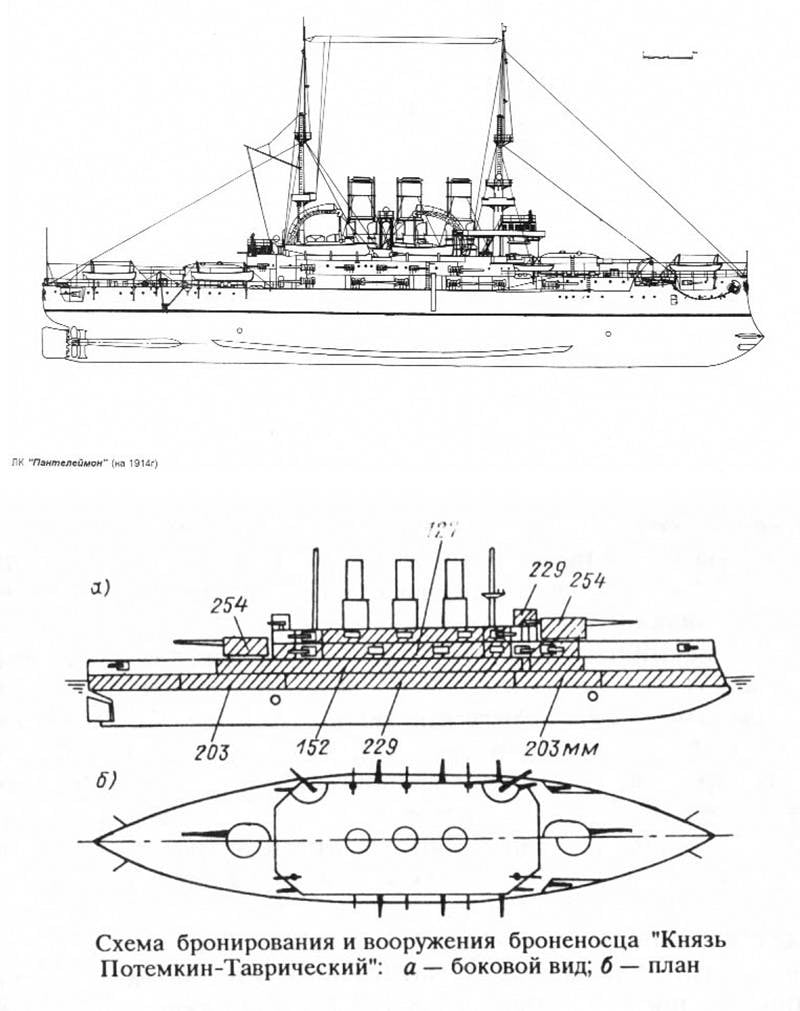
Both Shota himself and P. Gagarin, the shipbuilding drawing department employee, the author of the “St. Petersburg” project, urged the authorities, time and circumstances. After launching the battleship Rostislav in Nikolaev, the boathouse No. XXUMX was empty for the seventh month already. As a result, in the spring of 7, the revised project of engineer Schott won.
The marine technical committee could not stand aside and made a lot of amendments and additions to it. So, the distance between the decks was reduced by 152 mm to restore stability, two 152-mm guns were moved from the upper deck to the battery one. The armor protection of some sections of the deck and mine artillery was strengthened. At the same time, the proposal of Vice-Admiral Kopytov to abandon the virtually useless surface vehicles and the increasingly cumbersome ship mine boats was rejected.
Vice-Admiral Pavel Petrovich Tyrtov, head of the maritime ministry, endorsed the decision of the Committee with his resolution. It is worth noting that the heads of the working groups, engineers Schott and Gagarin, for completing a large amount of complex design work on a tight schedule were awarded 600 and 300 rubles, respectively.
Building
While the project of the ship was under development, the General Directorate of Shipbuilding and Supplies transferred the order for the manufacture of ship steel to government Izhora Plant. 7 July 1897, in the Nikolaevsky Admiralty, under the direction of the newly arrived from the capital Shott, the break-up of a new battleship on the plaza began. On the same day, the first batch of hull metal, brought from the Izhora plant by sea around Europe, was delivered on two barges from Odessa. Over the next two months, two more batches of steel arrived, bringing its total weight at the shipyard by October 1897 to 850 tons.
In addition to constantly delaying the statements of the drawings of the Marine Technical Committee, the Chief Commander of the Black Sea Fleet, Vice Admiral Kopytov, tirelessly and persistently intervened. On his instructions, permanent changes were made to the draft, from which Shott had to either fight back on the spot or coordinate them with Petersburg.
The relationship between the commander and the engineer became so complicated that Kopytov began to accuse Shott of incompetence. But the Marine Technical Committee supported Shot in a number of decisions made for speed over Kopytov’s head, and most of the “improvements” of the vice admiral were rejected. In addition to all design problems, the Izhora plant began to delay supplies of steel, the next batch of which was stuck for the winter of 1897 – 1898. in Odessa.
7 December 1897, the new battleship of the Black Sea Fleet, was given the highest order in the Marine Ministry by the name "Prince of Potemkin-Tavrichesky". 17 December of the same year, sheets of horizontal keel were collected on the slipway No. XXUMX of the Nikolaev Admiralty.
"Potemkin" was a large and complex ship. Initially, its displacement and basic dimensions corresponded to the “Three Saints”. True, the draft was somewhat less - 8,2 m. The battleship received a forecastle with a length of almost 80 meters.
The artillery, besides the four 305-mm guns in the two towers of the new type, consisted of sixteen 152-mm and fourteen 75-mm guns. In addition, there were eight quick-fire 47- and 37-mm guns. Torpedo armament was represented by five underwater vehicles for the development and manufacture of the Metal Plant in St. Petersburg. Armor protection "Potemkin", in contrast to its prototype, was somewhat lightweight. The maximum belt thickness was 229 mm and 203 mm in the extremities. The main caliber towers and conning tower were protected by plates with a thickness of 229 and 254 mm.
The ship was equipped with two triple-expansion vertical steam engines of 5300 l. with. and 22 Belleville water tube boilers, with a bow group of eight boilers providing oil heating. The estimated maximum speed was determined in 16 nodes, and the cruising range of the 10-node economic course was about 3600 miles. The reserves of solid and liquid fuels were 1100 tons. The crew of the battleship numbered 731 man, including 26 officers.
After the installation of the first parts of the hull set on the stocks, the work in the shed No. XXUMX was mothballed until the spring of the year 7. The scope of changes in the project turned out to be very large; the process of approving these changes was no less lengthy: the withdrawal of some drawings and the manufacture of new ones. Numerous counterparties also did not always show responsibility.
For example, the Baltiysky Zavod, the manufacturer of the mechanical part, strongly tightened with the working drawings. Vice Admiral Kopytov did not agree with the main axle and steam-hydraulic steering devices adopted in the project and suggested reworking them, with the latter offering to order in England. Approval of this decision and the release of working drawings took almost a year.
The manufacture of new towers of the main caliber was entrusted to the Naval plant, which had recently appeared in Nikolaev, but, despite the good mechanical equipment, this young enterprise did not have enough experience in such works. The Izhora plant for the third time recently had to restructure and modernize production for new plates, this time according to the Krupp model. Because of this and other delays, the main builder had in the summer of 1898 to fire a large number of workers who were out of work.
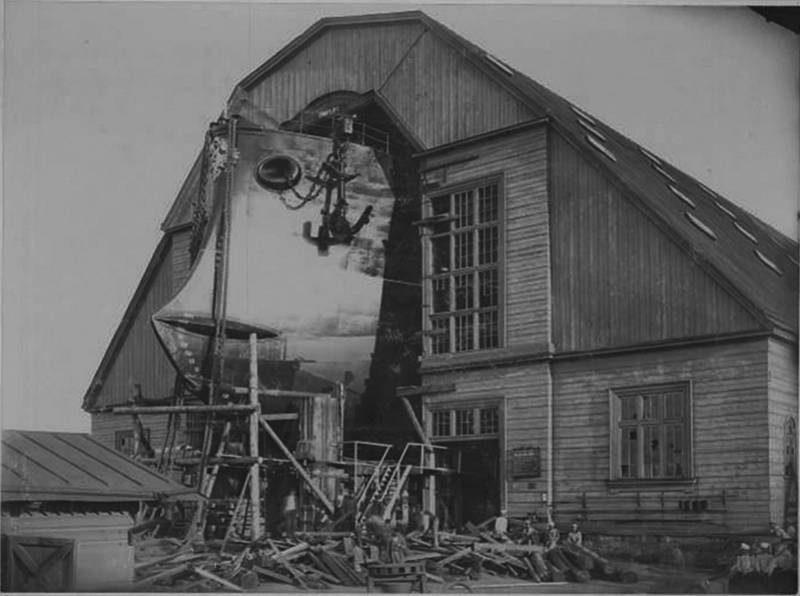
The battleship Potemkin was officially laid in the morning of September 28 1898. An embedded board weighing 160,6 grams of silver of the 84 test was ordered from Nikolayev's private jeweler A. M. Maurer in the number of 16 copies. In addition to the installation on the ship's horizontal keel, duplicates were distributed to the emperor, empress, heir, general admiral and other high authorities. One copy was traditionally transferred to the Maritime Museum.
The construction work on the Potemkin continued for 40 months - the construction was moving hard, with long delays and stops.
To be continued ...
Information